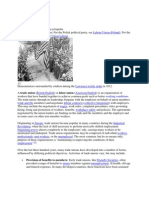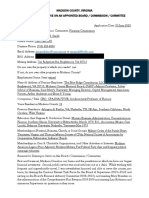Social Economy: Cooperator, To Promote Owen's Thinking, Having Already Set Up A Co-Operative Store in
Social Economy: Cooperator, To Promote Owen's Thinking, Having Already Set Up A Co-Operative Store in
Uploaded by
Prince ChiwuezeCopyright:
Available Formats
Social Economy: Cooperator, To Promote Owen's Thinking, Having Already Set Up A Co-Operative Store in
Social Economy: Cooperator, To Promote Owen's Thinking, Having Already Set Up A Co-Operative Store in
Uploaded by
Prince ChiwuezeOriginal Title
Copyright
Available Formats
Share this document
Did you find this document useful?
Is this content inappropriate?
Copyright:
Available Formats
Social Economy: Cooperator, To Promote Owen's Thinking, Having Already Set Up A Co-Operative Store in
Social Economy: Cooperator, To Promote Owen's Thinking, Having Already Set Up A Co-Operative Store in
Uploaded by
Prince ChiwuezeCopyright:
Available Formats
Main article: History of the cooperative movement Cooperation dates back as far as human beings have been organizing
for mutual benefit. Tribes were organised as cooperative structures, allocating jobs and resources among each other, only trading with the external communities. In alpine environments, trade could only be maintained in organized cooperatives to achieve a useful condition of artificial roads such as Viamala in 1473.[3] Pre-industrial Europe is home to the first cooperatives from an industrial context.[citation needed]
Robert Owen (1771 - 1858) was a social reformer and a pioneer of the cooperative movement. In 1761, the Fenwick Weavers' Society was formed in Fenwick, East Ayrshire, Scotland to sell discounted oatmeal to local workers.[4] Its services expanded to include assistance with savings and loans, emigration and education. In 1810, Welsh social reformer Robert Owen, from Newtown in mid-Wales, and his partners purchased New Lanark mill from Owen's father-in-law David Dale and proceeded to introduce better labour standards including discounted retail shops where profits were passed on to his employees. Owen left New Lanark to pursue other forms of cooperative organization and develop co-op ideas through writing and lecture. Cooperative communities were set up in Glasgow, Indiana and Hampshire, although ultimately unsuccessful. In 1828, William King set up a newspaper, The Cooperator, to promote Owen's thinking, having already set up a co-operative store in Brighton.[citation needed] The Rochdale Society of Equitable Pioneers, founded in 1844, is usually considered the first successful cooperative enterprise, used as a model for modern co-ops, following the 'Rochdale Principles'. A group of 28 weavers and other artisans in Rochdale, England set up the society to open their own store selling food items they could not otherwise afford. Within ten years there were over 1,000 cooperative societies in the United Kingdom.[citation needed] Other events such as the founding of a friendly society by the Tolpuddle Martyrs in 1832 were key occasions in the creation of organized labor and consumer movements.[citation needed]
[edit] Social economy
In the final year of the 20th century, cooperatives banded together to establish a number of social enterprise agencies which have moved to adopt the multi-stakeholder cooperative model.[5][6] In the last 15 years (19942009) the EU and its member nations, have gradually
revised national accounting systems to "make visible" the increasing contribution of social economy organizations.[7]
[edit] Organizational and ideological roots
The roots of the cooperative movement can be traced to multiple influences and extend worldwide. In the Anglosphere, post-feudal forms of cooperation between workers and owners, that are expressed today as "profit-sharing" and "surplus sharing" arrangements, existed as far back as 1795.[8] The key ideological influence on the Anglosphere branch of the cooperative movement, however, was a rejection of the charity principles that underpinned welfare reforms when the British government radically revised its Poor Laws in 1834. As both state and church institutions began to routinely distinguish between the 'deserving' and 'undeserving' poor, a movement of friendly societies grew throughout the British Empire based on the principle of mutuality, committed to self-help in the welfare of working people.[citation needed] Friendly Societies established forums through which one member, one vote was practiced in organisation decision-making. The principles challenged the idea that a person should be an owner of property before being granted a political voice.[5] Throughout the second half of the nineteenth century (and then repeatedly every 20 years or so) there has been a surge in the number of cooperative organisations, both in commercial practice and civil society, operating to advance democracy and universal suffrage as a political principle.[9] Friendly Societies and consumer cooperatives became the dominant form of organization amongst working people in Anglosphere industrial societies prior to the rise of trade unions and industrial factories. Weinbren reports that by the end of the 19th century, over 80% of British working age men and 90% of Australian working age men were members of one or more Friendly Society.[10] From the mid-nineteenth century, mutual organisations embraced these ideas in economic enterprises, firstly amongst tradespeople, and later in cooperative stores, educational institutes, financial institutions and industrial enterprises. The common thread (enacted in different ways, and subject to the constraints of various systems of national law) is the principle that an enterprise or association should be owned and controlled by the people it serves, and share any surpluses on the basis of each members' cooperative contribution (as a producer, labourer or consumer) rather than their capacity to invest financial capital.[11] The cooperative movement has been fueled globally by ideas of economic democracy. Economic democracy is a socioeconomic philosophy that suggests an expansion of decisionmaking power from a small minority of corporate shareholders to a larger majority of public stakeholders. There are many different approaches to thinking about and building economic democracy. Both Marxism and anarchism, for example, have been influenced by utopian socialism, which was based on voluntary cooperation, without recognition of class conflict. Anarchists are committed to libertarian socialism and they have focused on local organization, including locally managed cooperatives, linked through confederations of unions, cooperatives and communities. Marxists, who as socialists have likewise held and worked for the goal of democratizing productive and reproductive relationships, often placed a greater strategic emphasis on confronting the larger scales of human organization. As they viewed the capitalist class to be prohibitively politically, militarily and culturally mobilized in order to maintain an exploitable working class, they fought in the early 20th century to appropriate from the capitalist class the society's collective political capacity in the form of the state, either through democratic socialism, or through what came to be known as
Leninism. Though they regard the state as an unnecessarily oppressive institution, Marxists considered appropriating national and international-scale capitalist institutions and resources (such as the state) to be an important first pillar in creating conditions favorable to solidaristic economies.[12][13] With the declining influence of the USSR after the 1960s, socialist strategies pluralized, though economic democratizers have not as yet established a fundamental challenge to the hegemony of global neoliberal capitalism.
[edit] Meaning
[edit] Cooperatives as legal entities
A cooperative is a legal entity owned and democratically controlled by its members. Members often have a close association with the enterprise as producers or consumers of its products or services, or as its employees.[citation needed] In some countries, e.g. Finland and Sweden, there are specific forms of incorporation for cooperatives. Cooperatives may take the form of companies limited by shares or by guarantee, partnerships or unincorporated associations. In the USA, cooperatives are often organized as non-capital stock corporations under state-specific cooperative laws. However, they may also be unincorporated associations or business corporations such as limited liability companies or partnerships; such forms are useful when the members want to allow[citation needed]: 1. some members to have a greater share of the control, or 2. some investors to have a return on their capital that exceeds fixed interest, neither of which may be allowed under local laws for cooperatives. Cooperatives often share their earnings with the membership as dividends, which are divided among the members according to their participation in the enterprise, such as patronage, instead of according to the value of their capital shareholdings (as is done by a joint stock company).
[edit] Aspects of economic rationale
This article may contain original research. Please improve it by verifying the claims made and adding references. Statements consisting only of original research may be removed. More details may be available on the talk page. (January 2011) If cooperatives/mutuals succeed, that success may reflect not the characteristics of the cooperative/mutual form itself but the existence of a long term regulated competitive environment that created the space and margins which allowed them to adopt welfare objectives different from those of profit maximising competitors. Llewellyn and Holmes (1991) argue that, in the absence of a clear efficiency advantage, mutual building societies, for example, would need to behave in a manner substantially similar to banks and mutual life insurers similarly to Plc life insurers: "Only if mutuals have a substantial efficiency advantage compared with their Plc competitors are they able to set objectives significantly different from their Plc competitors. In the absence of this, competitive pressures force a convergence of behaviour and remove the major behavioural distinctions between mutuality and Plc's".[citation needed]
From this point of view, competition and narrow margins are inimical to the mutual form because they erode behavioural difference.[citation needed] These issues are complicated in the case of UK building societies and mutual life insurers because they require judgement about whether they really have behaved differently in these two areas. If banks may be different from building societies, that may not be so in the case of, for example, the UK Plc 'Prudential' life insurer and its mutual competitors. But, what is clear is that building societies (like mutual life insurers) have operated in regulated areas where returns on capital are high, so that mutuals can choose different objectives. This discretion, of course, greatly complicates outcomes because mutuals can set objectives in terms of prices received or paid or in terms of market access to those who would be denied access or disadvantaged by other providers. There is also the complication that if (as in the case of building societies in the late-1980s), mutuals dominate the field, the behaviour of non-mutual competitors has to be conjectured.[citation needed] Consumer attitudes and behaviour are also relevant when competition is weak. Consumers may prefer cooperatives/mutuals like building societies if they fear that surplus distributing banks might try to 'rip them off.' The point is made in the building society mutual context by Armitage (1991) in the following terms: "In theory, in a free market with well-informed participants, competition ensures competing services are priced according to their value to the consumer; if not they do not sell. Therefore, consumers are never 'ripped off'. However to the extent that a market is less than competitive in this sense, sellers have opportunities for exploiting customers, which their duty to shareholders should oblige them to take if they are companies, and their duty to members should oblige them not to take if they are mutuals. The mortgage and deposit markets are competitive, but not perfectly so. In particular, customers have incomplete information and face search costs. So there is scope for institutional policies to make a difference to customers' welfare without always paying or gaining in terms of loss or gain of custom".[citation needed] The fact that most small depositors are ill-informed (as building society depositors certainly were) may also explain the importance of mutuals in the savings markets. The Uninformed Depositor Model of Rasmusen (1988) does appear to offer explanation for why small savers prefer mutuals. In banking markets, there is usually information asymmetry whereby managers are relatively informed as to risk, such as asset risk and maturity transformation/interest yield mismatch risk, and depositors are left relatively ignorant. In this case, the cost of virtually any monitoring by small savers is practically unsustainable. The 'free rider' effect in building societies is a manifestation of this kind of unsustainable monitoring cost where the cost of meaningful involvement in building society affairs (even attendance at the annual meeting) really quite outweighs benefits to be obtained through involvement, as Ingham and Thompson 4 point out. In earlier times, some building societies resorted to fining members for not attending annual meetings, in order to get the members to turn out. But once the roll was checked many promptly adjourned to the nearest pub ('bar'). Under these risk-monitoring circumstances, depositors will, according to Rasmusen,3 prefer a mutual where they perceive that what they understand to be moderate or no risk attaches, due to regulation, as compared to more risky less regulated banks. Also, they may understand that managers in mutuals are less motivated to take risk, as suggested by Rasmusen (1988) below and by Masulis (1987).[citation needed] It could be claimed that part of the success of mutuals is due to simplified agency relationships resulting from the absence of external shareholders or to the ability to distribute
surplus through product price (not 'Plc' dividend). These arguments are not conclusive, as the presence of external claimants may result in considerable pressure for cost economies, especially if there is a market for corporate control. It is doubtful that the operating cost leadership of UK building societies, which is so much a factor in the dominance of the mutual form in the savings banking and home mortgage financing market, has much to do with lower agency costs or efficiency. Before deregulation, the objective was not efficiency but growth through retained earnings which was in the management interest; and the finance directors attributed their funding cost advantage to the accident of mixed funding. Much of this detail may not matter to an uninformed depositor. As Rasmusen (1988) observes: "In the Uninformed Depositor Model the depositor does not have to distinguish motives: the advantage of the mutual is that the interests of depositors and managers roughly coincide, and whether managers are conservative to protect their perks or their depositors is a minor point".[citation needed] Masulis (1987) also refers to the motivations of managers in relation to risk in the following terms with reference to American style mutual savings and loan banks where his references to 'owners' and boards of directors, in the MS&L [mutual savings and loan] context, are references to management: "Since MS&L owners (boards of directors) are only able to extract a portion of a S&L's current and accumulated earnings [through salary and perks], they have less incentive to take risks than the owners of stock companies [e.g. Plc banks] who can capture the entire stream of accumulated and expected future profits by selling their stock.[citation needed]
[edit] Identity
Cooperatives are based on the cooperative values of "self-help, self-responsibility, democracy and equality, equity and solidarity" and the seven cooperative principles:[14] 1. 2. 3. 4. 5. 6. 7. Voluntary and Open Membership Democratic Member Control Member Economic Participation Autonomy and Independence Education, Training and Information Cooperation among Cooperatives Concern for Community
Cooperatives are dedicated to the values of openness, social responsibility and caring for others. Such legal entities have a range of social characteristics. Membership is open, meaning that anyone who satisfies certain non-discriminatory conditions may join. Economic benefits are distributed proportionally to each member's level of participation in the cooperative, for instance by a dividend on sales or purchases, rather than according to capital invested.[14] Cooperatives may be classified as either worker, consumer, producer, purchasing or housing cooperatives.[15] They are distinguished from other forms of incorporation in that profit-making or economic stability are balanced by the interests of the community.[14] Co-ops can sometimes be identified on the Internet through the use of the .coop gTLD. Organizations using .coop domain names must adhere to the basic co-op values.
[edit] Types of cooperative governance
[edit] Retailers' cooperative
Main article: Retailers' cooperative A retailers' cooperative (known as a secondary or marketing cooperative in some countries) is an organization which employs economies of scale on behalf of its members to get discounts from manufacturers and to pool marketing. It is common for locally owned grocery stores, hardware stores and pharmacies. In this case the members of the cooperative are businesses rather than individuals.[citation needed] The Best Western international hotel chain is actually a retailers' cooperative, whose members are hotel operators, although it now prefers to call itself a "nonprofit membership association." It gave up on the "cooperative" label after some courts insisted on enforcing regulatory requirements for franchisors despite its member-controlled status.[citation needed]
[edit] Worker cooperative
Main article: Worker cooperative A worker cooperative or producer cooperative is a cooperative, that is owned and democratically controlled by its "worker-owners". There are no outside owners in a "pure" workers' cooperative, only the workers own shares of the business, though hybrid forms exist in which consumers, community members or capitalist investors also own some shares. In practice, control by worker-owners may be exercised through individual, collective or majority ownership by the workforce, or the retention of individual, collective or majority voting rights (exercised on a one-member one-vote basis).[16] A worker cooperative, therefore, has the characteristic that the majority of its workforce owns shares, and the majority of shares are owned by the workforce.[17] Membership is not always compulsory for employees, but generally only employees can become members either directly (as shareholders) or indirectly through membership of a trust that owns the company.[citation needed] The impact of political ideology on practice constrains the development of cooperatives in different countries. In India, there is a form of workers' cooperative which insists on compulsory membership for all employees and compulsory employment for all members. That is the form of the Indian Coffee Houses. This system was advocated by the Indian communist leader A. K. Gopalan. In places like the UK, common ownership (indivisible collective ownership) was popular in the 1970s. Cooperative Societies only became legal in Britain after the passing of Slaney's Act in 1852. In 1865 there were 651 registered societies with a total membership of well over 200,000.[18] There are now more than 400 worker cooperatives in the UK,[19] Suma Wholefoods being the largest example with a turnover of 24 million.[citation needed] Spanish law permits owner-members to register as self-employed enabling worker-owners to establish regulatory regimes that support cooperative working, but which differs considerably from cooperatives that are subject to Anglo-American systems of law that require the cooperative (employer) to view (and treat) its worker-members as salaried workers (employees).[20] The implications of this are far-reaching, as this requires cooperatives to establish authority driven statutory disciplinary and grievance procedures (rather than democratic mediation schemes), impacting on the ability of leaders to enact democratic forms
of management and counter the authority structures embedded in the dominant system of private enterprise centred around the entrepreneur.[21] [edit] Volunteer cooperative A volunteer cooperative is a cooperative that is run by and for a network of volunteers, for the benefit of a defined membership or the general public, to achieve some goal. Depending on the structure, it may be a collective or mutual organization, which is operated according to the principles of cooperative governance. The most basic form of volunteer-run cooperative is a voluntary association. A lodge or social club may be organized on this basis. A volunteerrun co-op is distinguished from a worker cooperative in that the latter is by definition employee-owned, whereas the volunteer cooperative is typically a non-stock corporation, volunteer-run consumer co-op or service organization, in which workers and beneficiaries jointly participate in management decisions and receive discounts on the basis of sweat equity.[citation needed]
[edit] Social cooperative
Main article: Social cooperative A particularly successful form of multi-stakeholder cooperative is the Italian "social cooperative", of which some 7,000 exist. "Type A" social cooperatives bring together providers and beneficiaries of a social service as members. "Type B" social cooperatives bring together permanent workers and previously unemployed people who wish to integrate into the labour market. They are legally defined as follows:[22]
no more than 80% of profits may be distributed, interest is limited to the bond rate and dissolution is altruistic (assets may not be distributed) the cooperative has legal personality and limited liability the objective is the general benefit of the community and the social integration of citizens those of type B integrate disadvantaged people into the labour market. The categories of disadvantage they target may include physical and mental disability, drug and alcohol addiction, developmental disorders and problems with the law. They do not include other factors of disadvantage such as unemployment, race, sexual orientation or abuse. type A cooperatives provide health, social or educational services various categories of stakeholder may become members, including paid employees, beneficiaries, volunteers (up to 50% of members), financial investors and public institutions. In type B cooperatives at least 30% of the members must be from the disadvantaged target groups voting is one person one vote
A good estimate of the current size of the social cooperative sector in Italy is given by updating the official Istituto Nazionale di Statistica (Istat) figures from the end of 2001 by an annual growth rate of 10% (assumed by the Direzione Generale per gli Ente Cooperativi). This gives totals of 7,100 social cooperatives, with 267,000 members, 223,000 paid employees, 31,000 volunteers and 24,000 disadvantaged people undergoing integration. Combined turnover is around 5 billion euro. The cooperatives break into three types: 59%
type A (social and health services), 33% type B (work integration) and 8% mixed. The average size is 30 workers.[citation needed]
The volunteer board of a retail consumers' cooperative, such as the former Oxford, Swindon & Gloucester Co-op, is held to account at an Annual General Meeting of members
[edit] Consumers' cooperative
Main article: Consumers' cooperative A consumers' cooperative is a business owned by its customers. Employees can also generally become members. Members vote on major decisions and elect the board of directors from amongst their own number. The first of these was set up in 1844 in the NorthWest of England by 28 weavers who wanted to sell food at a lower price than the local shops. A well known example in the United States is the REI (Recreational Equipment Incorporated) co-op, and in Canada: Mountain Equipment Co-op.[citation needed] With its 414,383 employees, 7,736,210 members and a turnover of 50Bn per year growing at a steady rate of 4.41%,[23] Legacoop[24] of Italy is arguably the world's biggest federation of cooperatives.[citation needed] The world's largest consumers' cooperative is the Co-operative Group in the United Kingdom, which offers a variety of retail and financial services. The UK also has a number of autonomous consumers' cooperative societies, such as the East of England Co-operative Society and Midcounties Co-operative. In fact, the Co-operative Group is something of a hybrid, having both corporate members (mostly other consumers' cooperatives, as a result of its origins as a wholesale society), and individual retail consumer members.[citation needed] Japan has a very large and well-developed consumer cooperative movement with over 14 million members; retail co-ops alone had a combined turnover of 2.519 trillion Yen (21.184 billion US dollars [market exchange rates as of 15 November 2005]) in 2003/4.[25] Migros is the largest supermarket chain in Switzerland and has around 2 million of the country's 7.2 million population as members.[citation needed] Switzerland's second-biggest supermarket chain, Coop is also a cooperative. In 2001, it merged with 11 cooperative federations which had been its main suppliers for over 100 years.[citation needed] As of 2005, Coop operates 1,437 shops and employs almost 45,000 people. According to Bio Suisse, the Swiss organic producers' association, Coop accounts for half of all the organic food sold in Switzerland.[citation needed] Euro Coop is the European Community of Consumer Cooperatives.
[edit] Business and employment cooperative
Main article: Business and employment co-operative Business and employment cooperatives (BECs) are a subset of worker cooperatives that represent a new approach to providing support to the creation of new businesses.[citation needed] Like other business creation support schemes, BECs enable budding entrepreneurs to experiment with their business idea while benefiting from a secure income. The innovation BECs introduce is that once the business is established the entrepreneur is not forced to leave and set up independently, but can stay and become a full member of the cooperative. The micro-enterprises then combine to form one multi-activity enterprise whose members provide a mutually supportive environment for each other.[citation needed] BECs thus provide budding business people with an easy transition from inactivity to selfemployment, but in a collective framework. They open up new horizons for people who have ambition but who lack the skills or confidence needed to set off entirely on their own or who simply want to carry on an independent economic activity but within a supportive group context.[citation needed]
[edit] New generation cooperative
New generation cooperatives (NGCs) are an adaptation of traditional cooperative structures to modern, capital intensive industries. They are sometimes described as a hybrid between traditional co-ops and limited liability companies. They were first developed in California and spread and flourished in the US Mid-West in the 1990s.[26] They are now common in Canada where they operate primarily in agriculture and food services, where their primary purpose is to add value to primary products. For example producing ethanol from corn, pasta from durum wheat, or gourmet cheese from goats milk.[27]
[edit] Types of cooperatives
[edit] Housing cooperative
Co-op City in New York is the largest cooperative housing development in the world with 55,000 people.[28] Main article: Housing cooperative A housing cooperative is a legal mechanism for ownership of housing where residents either own shares (share capital co-op) reflecting their equity in the cooperative's real estate, or have membership and occupancy rights in a not-for-profit cooperative (non-share capital co-op), and they underwrite their housing through paying subscriptions or rent.[citation needed]
Housing cooperatives come in three basic equity structures[citation needed]:
In Market-rate housing cooperatives, members may sell their shares in the cooperative whenever they like for whatever price the market will bear, much like any other residential property. Market-rate co-ops are very common in New York City. Limited equity housing cooperatives, which are often used by affordable housing developers, allow members to own some equity in their home, but limit the sale price of their membership share to that which they paid. Group equity or Zero equity housing cooperatives do not allow members to own equity in their residences and often have rental agreements well below market rates.
Main article: Building cooperative Members of a building cooperative (in Britain known as a self-build housing cooperative) pool resources to build housing, normally using a high proportion of their own labour. When the building is finished, each member is the sole owner of a homestead, and the cooperative may be dissolved.[citation needed] This collective effort was at the origin of many of Britain's building societies, which however developed into "permanent" mutual savings and loan organisations, a term which persisted in some of their names (such as the former Leeds Permanent). Nowadays such self-building may be financed using a step-by-step mortgage which is released in stages as the building is completed.[citation needed] The term may also refer to worker cooperatives in the building trade.[citation needed]
[edit] Utility cooperative
Main article: Utility cooperative A utility cooperative is a type of consumers' cooperative that is tasked with the delivery of a public utility such as electricity, water or telecommunications services to its members. Profits are either reinvested into infrastructure or distributed to members in the form of "patronage" or "capital credits", which are essentially dividends paid on a member's investment into the cooperative. In the United States, many cooperatives were formed to provide rural electrical and telephone service as part of the New Deal. See Rural Utilities Service.[citation needed] In the case of electricity, cooperatives are generally either generation and transmission (G&T) co-ops that create and send power via the transmission grid or local distribution coops that gather electricity from a variety of sources and send it along to homes and businesses.[29] In Tanzania, it has been proven that the cooperative method is helpful in water distribution. When the people are involved with their own water, they care more because the quality of their work has a direct effect on the quality of their water.[30]
[edit] Agricultural cooperative
Grain elevators are used by agricultural cooperatives in the storage and shipping of grains. Main article: Agricultural cooperative Agricultural cooperatives or farmers' cooperatives are cooperatives where farmers pool their resources for mutual economic benefit. Agricultural cooperatives are broadly divided into agricultural service cooperatives, which provide various services to their individual farming members, and agricultural production cooperatives, where production resources such as land or machinery are pooled and members farm jointly.[31] Agricultural production cooperatives are relatively rare in the world, and known examples are limited to collective farms in former socialist countries and the kibbutzim in Israel.[citation needed] Agricultural supply cooperatives aggregate purchases, storage, and distribution of farm inputs for their members. By taking advantage of volume discounts and utilizing other economies of scale, supply cooperatives bring down members' costs. Supply cooperatives may provide seeds, fertilizers, chemicals, fuel, and farm machinery. Some supply cooperatives also operate machinery pools that provide mechanical field services (e.g., plowing, harvesting) to their members.[citation needed] Agricultural marketing cooperatives provide the services involved in moving a product from the point of production to the point of consumption. Agricultural marketing includes a series of inter-connected activities involving planning production, growing and harvesting, grading, packing, transport, storage, food processing, distribution and sale. Agricultural marketing cooperatives are often formed to promote specific commodities.[citation needed]
[edit] Credit
You might also like
- Swot Analysis of Pee Dee Electric CooperativeDocument5 pagesSwot Analysis of Pee Dee Electric CooperativeLeah Mariz RocaNo ratings yet
- Social Enterprise Planning ToolkitDocument71 pagesSocial Enterprise Planning ToolkitChen MenciasNo ratings yet
- Co-Operative Society in BangladeshDocument19 pagesCo-Operative Society in BangladeshProtibibadi50% (4)
- Fundamentals of CooperativeDocument16 pagesFundamentals of Cooperativewilliam penalverNo ratings yet
- Consumer Co-OperativeDocument14 pagesConsumer Co-Operativeadv_jNo ratings yet
- Origins: International Cooperative Alliance's Statement On The Cooperative Identity Autonomous Associations EnterprisesDocument14 pagesOrigins: International Cooperative Alliance's Statement On The Cooperative Identity Autonomous Associations EnterprisesYen Tan PomidaNo ratings yet
- A Cooperative WikipediaDocument14 pagesA Cooperative WikipediaKeiko Gwendoline VictoriaNo ratings yet
- Co OperativeDocument11 pagesCo OperativeJasbeer SinghNo ratings yet
- Enterprise: Citation NeededDocument3 pagesEnterprise: Citation NeededInday MiraNo ratings yet
- Assignment On Cooperative Society.Document12 pagesAssignment On Cooperative Society.Aftab Uddin67% (3)
- AssignmentDocument13 pagesAssignmentAftab UddinNo ratings yet
- Assignment On Cooperative SocietyDocument12 pagesAssignment On Cooperative SocietyAnkit KumarNo ratings yet
- MGMT of Cooperative and Other Organization Power PointDocument181 pagesMGMT of Cooperative and Other Organization Power PointyemaneNo ratings yet
- Cooperativism As A Way of LifeDocument48 pagesCooperativism As A Way of LifeZebulun DocallasNo ratings yet
- Cooperatives Perspectives in TanzaniaDocument10 pagesCooperatives Perspectives in TanzaniaMichael NyaongoNo ratings yet
- Consumers' Co-Operative - WikipediaDocument10 pagesConsumers' Co-Operative - WikipediaMr. MeNo ratings yet
- What Is The Relevance of Co-Operative Society To Nigeria EconmyDocument14 pagesWhat Is The Relevance of Co-Operative Society To Nigeria EconmyOshinfowokan OloladeNo ratings yet
- 05 - Chapter 3 PDFDocument34 pages05 - Chapter 3 PDFAnonymous ZvmioyRK2No ratings yet
- Housing CooperativeDocument4 pagesHousing CooperativeSarah AustinNo ratings yet
- Trade Union - Wikipedia PDFDocument28 pagesTrade Union - Wikipedia PDFIgnacio AzpiazuNo ratings yet
- Trade Union: "Labour Union" Redirects Here. For The Polish Political Party, See - For The Canadian Political Party, SeeDocument38 pagesTrade Union: "Labour Union" Redirects Here. For The Polish Political Party, See - For The Canadian Political Party, SeeReddy BabuNo ratings yet
- Module 1 5 FINAL 2021Document48 pagesModule 1 5 FINAL 2021Marites De VeraNo ratings yet
- CooperationDocument10 pagesCooperationNEERAJA UNNINo ratings yet
- Cooperatives in Romania UJCC MaramuresDocument15 pagesCooperatives in Romania UJCC MaramuresDiana CiobanuNo ratings yet
- Social Enterprise Planning ToolkitDocument70 pagesSocial Enterprise Planning ToolkitXerxa Lingan100% (2)
- Paper -V Co-operative Management and AdministrationDocument122 pagesPaper -V Co-operative Management and Administrationmonathiru1713No ratings yet
- 09 - Chapter 3 PDFDocument43 pages09 - Chapter 3 PDFJuManHaqZzNo ratings yet
- History of The Cooperative MovementDocument2 pagesHistory of The Cooperative MovementshabukrNo ratings yet
- Consumers' Co-Operative - WikipediaDocument9 pagesConsumers' Co-Operative - WikipediaJameson Theisen100% (1)
- Cooperative V200Document19 pagesCooperative V200Marcos, Jayven B.No ratings yet
- Co-Operative Movement in The WorldDocument3 pagesCo-Operative Movement in The Worldsukumar_paitandiNo ratings yet
- Chater 6Document3 pagesChater 6praveenmetri90No ratings yet
- Capter 5Document3 pagesCapter 5praveenmetri90No ratings yet
- Rapid Expansion of Industrial Society: RerumnovarumDocument3 pagesRapid Expansion of Industrial Society: RerumnovarumvenkatNo ratings yet
- Trade Union: Provision of Benefits To Members: Early Trade Unions, LikeDocument27 pagesTrade Union: Provision of Benefits To Members: Early Trade Unions, LikeSayantan ChatterjeeNo ratings yet
- Boyd - Political Economy of Alternative Models (M.lewis Highlighting)Document44 pagesBoyd - Political Economy of Alternative Models (M.lewis Highlighting)thunderdomeNo ratings yet
- 116929-Article Text-324490-1-10-20150514Document11 pages116929-Article Text-324490-1-10-20150514Nofiu Moshood OlaideNo ratings yet
- Co-Operative Banks-A Helping Hand For Small and Medium EnterprisesDocument4 pagesCo-Operative Banks-A Helping Hand For Small and Medium EnterprisesSandhya GNo ratings yet
- Collective Bargaining:: Where Trade Unions Are Able To Operate Openly and Are Recognized byDocument14 pagesCollective Bargaining:: Where Trade Unions Are Able To Operate Openly and Are Recognized byAsiya AnjumNo ratings yet
- Chapter-1: 1.1 Genesis of The Term Co-Operative'Document22 pagesChapter-1: 1.1 Genesis of The Term Co-Operative'inpbm0No ratings yet
- Trade Union: Labour Union (Poland) Union LabourDocument26 pagesTrade Union: Labour Union (Poland) Union Labourddlj70No ratings yet
- What Is A Co-Operative?: Share ShareDocument7 pagesWhat Is A Co-Operative?: Share ShareMarian GrajdanNo ratings yet
- Chapter 2Document3 pagesChapter 2praveenmetri90No ratings yet
- BAFT Cooperation I Module IDocument12 pagesBAFT Cooperation I Module IBeyond the Thoughts ANNo ratings yet
- Type Worker Cooperative - Wikipedia PDFDocument21 pagesType Worker Cooperative - Wikipedia PDFAmaan ShehbazNo ratings yet
- Cooperative Societies WriteupDocument8 pagesCooperative Societies WriteupSagargn SagarNo ratings yet
- Polytechnic University of The Philippines San Pedro Campus, LagunaDocument21 pagesPolytechnic University of The Philippines San Pedro Campus, LagunaSheen Heidelberg EstevesNo ratings yet
- Coop20013 Principles and Philosophies of CooperativismDocument28 pagesCoop20013 Principles and Philosophies of CooperativismMichelle SoguilonNo ratings yet
- Rjj$-Sejv .zv6 Zy)Document21 pagesRjj$-Sejv .zv6 Zy)Serenity ManaloNo ratings yet
- Definition of Credit and CollectionsDocument5 pagesDefinition of Credit and CollectionsDrew MerezNo ratings yet
- The Role of Trade Union in The 21st Century OrganizationsDocument12 pagesThe Role of Trade Union in The 21st Century OrganizationspasinduNo ratings yet
- Trade UnionDocument12 pagesTrade UnionMavreen Gordon-TeagueNo ratings yet
- Moral Economy and Civil Society in Eighteenth Century Europe The Case of Economic Societies and The Business of ImprovementDocument14 pagesMoral Economy and Civil Society in Eighteenth Century Europe The Case of Economic Societies and The Business of ImprovementjapNo ratings yet
- Alice Cooperative1Document7 pagesAlice Cooperative1Bernie BenastoNo ratings yet
- 09 Chapter 3Document56 pages09 Chapter 3madhu vinayNo ratings yet
- Vieta - Beyond CapitalismDocument11 pagesVieta - Beyond CapitalismJUAN PABLO ARRUE FONSECA100% (1)
- Principles Short HistoryDocument8 pagesPrinciples Short HistoryIvan AdityaNo ratings yet
- ASA Industrial Welfare UNIT 111 - Trade UnionismDocument8 pagesASA Industrial Welfare UNIT 111 - Trade Unionismgodwinnasser110No ratings yet
- People Over Capital: The Co-operative Alternative to CapitalismFrom EverandPeople Over Capital: The Co-operative Alternative to CapitalismRating: 4.5 out of 5 stars4.5/5 (6)
- Mobilizing against Inequality: Unions, Immigrant Workers, and the Crisis of CapitalismFrom EverandMobilizing against Inequality: Unions, Immigrant Workers, and the Crisis of CapitalismLee H. AdlerNo ratings yet
- Madison County Planning Commission Application - Jim SmithDocument26 pagesMadison County Planning Commission Application - Jim SmithChuck JacksonNo ratings yet
- Meralco Kuryente WatchDocument2 pagesMeralco Kuryente WatchGerald GaciasNo ratings yet
- Reading ComprehensionDocument13 pagesReading ComprehensionJan Ellard CruzNo ratings yet
- Housing CooperativeDocument4 pagesHousing CooperativeSarah AustinNo ratings yet
- Albay Electric Cooperative, Inc. (Aleco) : 2017 Budget Utilization ReportDocument12 pagesAlbay Electric Cooperative, Inc. (Aleco) : 2017 Budget Utilization ReportEdsel Alfred OtaoNo ratings yet
- ENGLISH VOCABULARY and GRAMMAR 1 130Document14 pagesENGLISH VOCABULARY and GRAMMAR 1 130Robert VillarNo ratings yet
- Final Rules - Annex A of Res20Document37 pagesFinal Rules - Annex A of Res20Angelica LeonorNo ratings yet
- Acp Provider ListDocument799 pagesAcp Provider ListC SNo ratings yet
- Organization and Registration of CooperativesDocument55 pagesOrganization and Registration of CooperativesClaire AsiertoNo ratings yet
- Broadband Provider Name DBA Name Holding Company: T-Mobile USA, Inc. Deutsche Telekom AGDocument709 pagesBroadband Provider Name DBA Name Holding Company: T-Mobile USA, Inc. Deutsche Telekom AGlanav4562No ratings yet
- e0e0b24d8ab1767be1afb7df0a61878aDocument35 pagese0e0b24d8ab1767be1afb7df0a61878areasonorgNo ratings yet






































































